Topic 2: Misc. Questions
You plan to deploy a high availability SAP environment that will use a failover clustering solution. You have an Azure Resource Manager template that you will use for the deployment. You have the following relevant portion of the template.
What is created by the template?
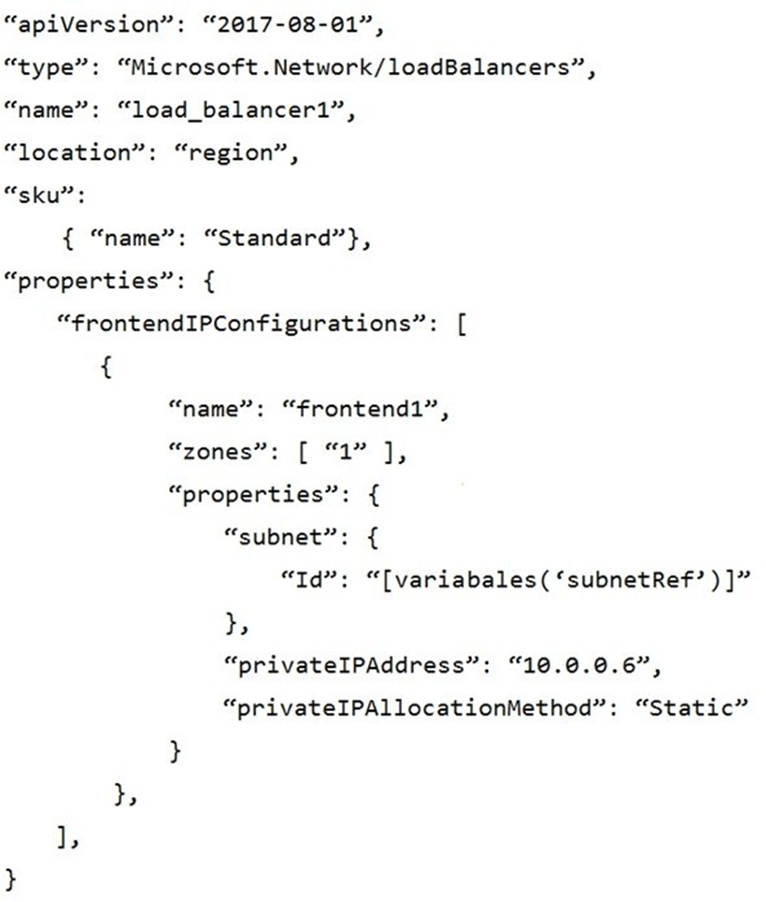
A.
a zonal frontend IP address for the internal Azure Standard Load Balancer
B.
a zone-redundant frontend IP address for the internal Azure Basic Load Balancer
C.
a zone -redundant public IP address for the internal load balancer
D.
a zone-redundant frontend IP address for the internal Azure Standard Load Balancer
a zonal frontend IP address for the internal Azure Standard Load Balancer
Explanation: https://docs.microsoft.com/en-us/azure/load-balancer/load-balancer- standard-availability-zones
You deploy an Azure Internal load balancer. You deploy a node of an SAP NetWeaver 7.4 ABAP system named SP1. You plan to deploy a second node.You need to verify that the health probe port is configured for the cluster. The cluster IP address resource name is SAP SP1 IP. How should you complete the command? To answer, select the appropriate options in the answer area.
NOTE: Each correct selection is worth one point.
A picture
containing text
Description automatically generated

Answer:

Explanation:

Box 1: Get-ClusterResource Example:
Get-ClusterResource -Name $SAPIPresourceName | Get-ClusterParameter
Write-Output " "
Write-Output "Current probe port property of the SAP cluster resource '$SAPIPresourceName' is '$OldProbePort'."
Write-Output " "
Write-Output "Setting the new probe port property of the SAP cluster resource '$SAPIPresourceName' to '$ProbePort' ..."
Write-Output " "
Box 2: Get-ClusterParameter
You have an SAP production landscape on Azure that contains the virtual machines shown in the following table.

You configure HANA system replication as shown in the following table.

You configure two load balancers as shown in the following table.


Answer:

You have an on-premises SAP NetWeaver production landscape and an Azure subscription that contains the resources shown in the following table.
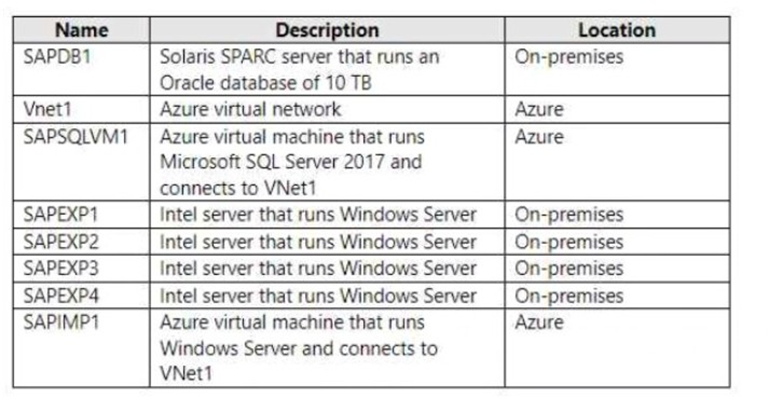
You have a 10-Gbps ExpressRoute circuit between the on-premises environment and VNet1. You plan to migrate the landscape to Azure. SAPSQLVM1. The solution must minimize how long it will take to complete the data migration.
What should you use? To answer, select the appropriate options in the answer area. NOTE: Each correct selection is worth one point.

Answer:


You have an on-premises SAP environment that runs on SUSE Linux Enterprise Server (SLES) servers and Oracle. The version of the SAP ERP system is 6.06 and the version of the portal is SAP NetWeaver 7.3. You need to recommend a migration strategy to migrate the SAP ERP system and the portal to Azure. The solution must be hosted on SAP HANA. What should you recommend? To answer, drag the appropriate tools to the correct components. Each tool may be used once, more than once, or not at all. You may need to drag the split bar between panes or scroll to view content.
NOTE: Each correct selection is worth one point.

Answer:

Explanation:
1) SUM+DMO+System update.
2) Heterogeneous system copy.
You have an instance of SAP NANA on Azure (Large Instances) named HIM. You plan to deploy Azure virtual machines. The virtual machines will host application servers that will access the database on HLI1. You need to minimize latency between the application servers and HLH What should you do? To answer, select the appropriate options m the answer area NOTE: Each correct selection is worth one point.
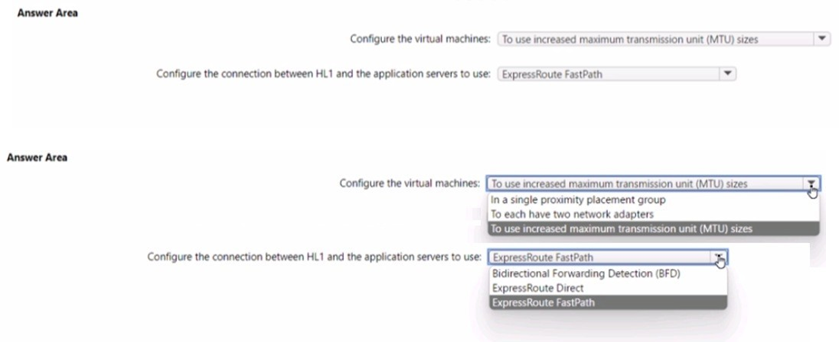
Answer:
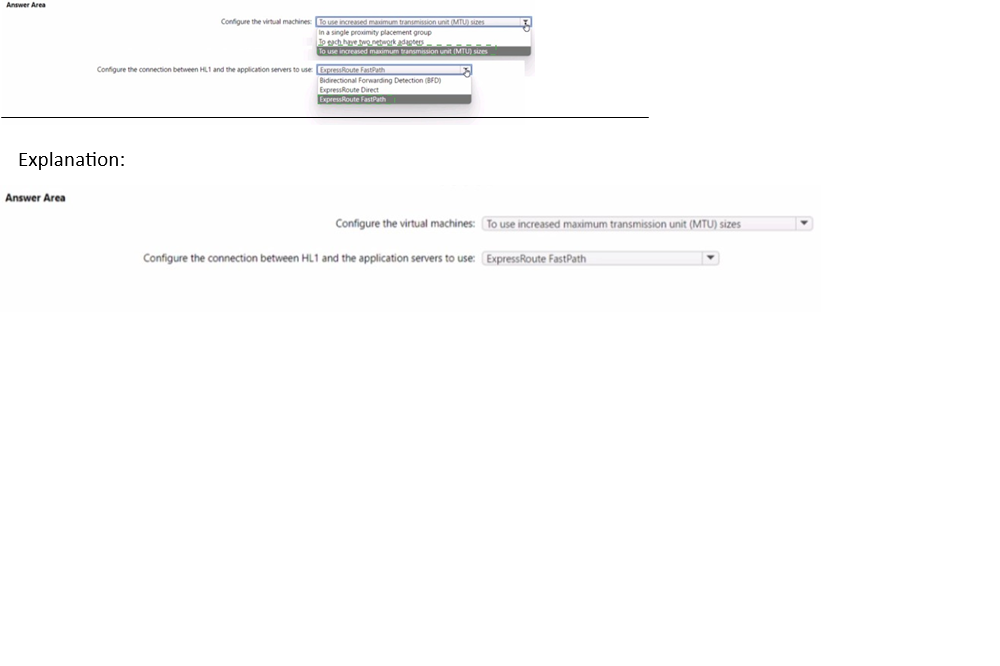
You deploy SAP HANA by using SAP HANA on Azure (Large Instances). For each of the following statements, select Yes if the statement is true. Otherwise, select No. NOTE: Each correct selection is worth one point.
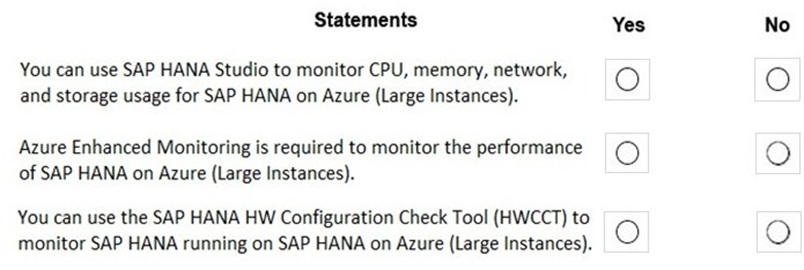
Answer:
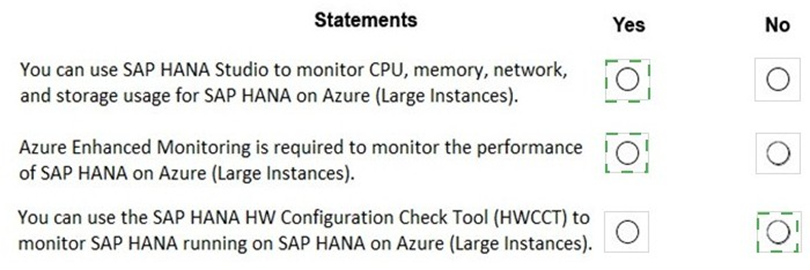
Box 1: Yes
Box 2: Yes
The SAP Azure Enhanced Monitoring Extension allows for collecting diagnostic data including OS and Application performance counters from Azure VMs running SAP workloads.
Box 3: No References:
http://www.deployazure.com/compute/virtual-machines/sap-azure-enhanced-monitoring- extension/
https://docs.microsoft.com/en-us/azure/virtual-machines/workloads/sap/azure-monitor- overview
You are planning the Azure network infrastructure for an SAP environment. For each of the following statements, select Yes if the statement is true. Otherwise, select No. NOTE: Each correct selection is worth one point.
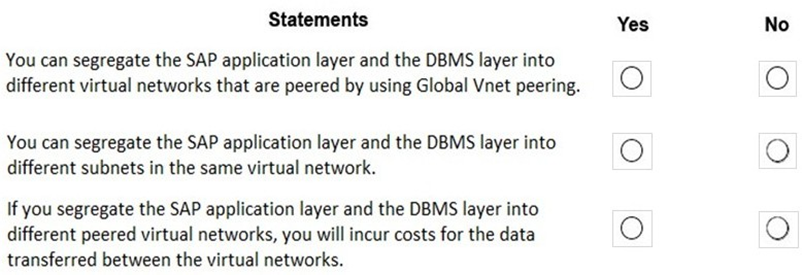
Answer:
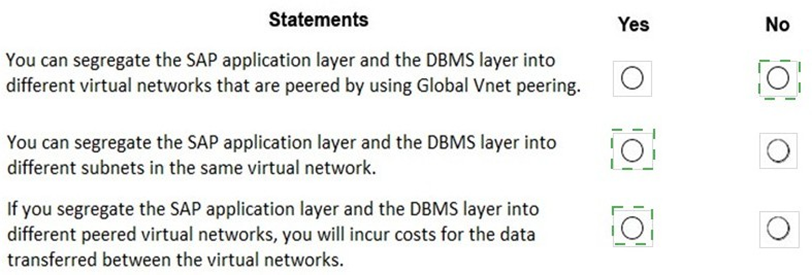
Explanation:
Box 1: NO
Box 2: Yes
Box 3: Yes
Be aware that network traffic between two peered Azure virtual networks is subject to transfer costs. Huge data volume that consists of many terabytes is exchanged between the SAP application layer and the DBMS layer. You can accumulate substantial costs if the SAP application layer and DBMS layer are segregated between two peered Azure virtual networks.
References:
https://docs.microsoft.com/en-us/azure/virtual- machines/workloads/sap/dbms_guide_general
You plan to migrate an SAP database from Oracle to Microsoft SQL Server by using the SQL Server Migration Assistant (SSMA).
You are configuring a Proof of Concept (PoC) for the database migration You plan to perform the migration multiple times as part of the PoC. You need to ensure that you can perform the migrations as quickly as possible. The solution must ensure that all Oracle schemas are migrated. Which migration method and migration mode should you use? To answer, select the appropriate options in the answer area NOTE: Each correct selection is worth one point.
Answer: Answer: see the explanation for below image:
Explanation:
Answer selected as in image below.
Answer:

For each of the following statements, select Yes if the statement is true. Otherwise, select No. NOTE: Each correct selection is worth one point.

Answer:

Explanation:

You have SAP ERP on Azure. For SAP high availability, you plan to deploy ASCS/ERS instances across Azure Availability Zones and to use failover clusters. For each of the following statements, select Yes if the statement is true. Otherwise, select No. NOTE: Each correct selection is worth one point.

Answer:

Explanation:

Box 1: No
You can't use an Azure Basic Load Balancer to create failover cluster solutions based on Windows Server Failover Clustering or Linux Pacemaker. Instead, you need to use the Azure Standard Load Balancer SKU.
Box 2: Yes
Azure Availability Zones is one of the high-availability features that Azure provides. Using Availability Zones improves the overall availability of SAP workloads on Azure.
The SAP application layer is deployed across one Azure availability set. For high availability of SAP Central Services, you can deploy two VMs in a separate availability set.
Box 3: Yes
You must use Azure Managed Disks when you deploy to Azure Availability Zones.
You plan to deploy multiple SAP HANA virtual machines to Azure by using an Azure Resource Manager template. How should you configure Accelerated Networking and Write Accelerator in the template? To answer, drag the appropriate values to the correct targets. Each value may be used once, more than once, or not at all. You may need to drag the split bar between panes or scroll to view content. NOTE: Each correct selection is worth one point.
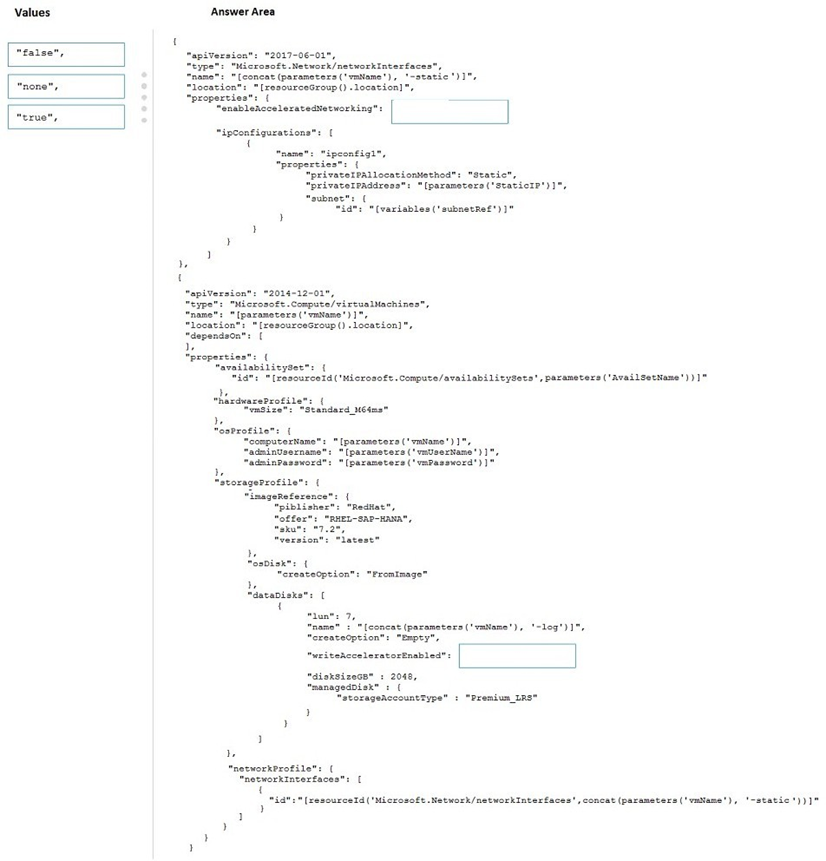
Answer:
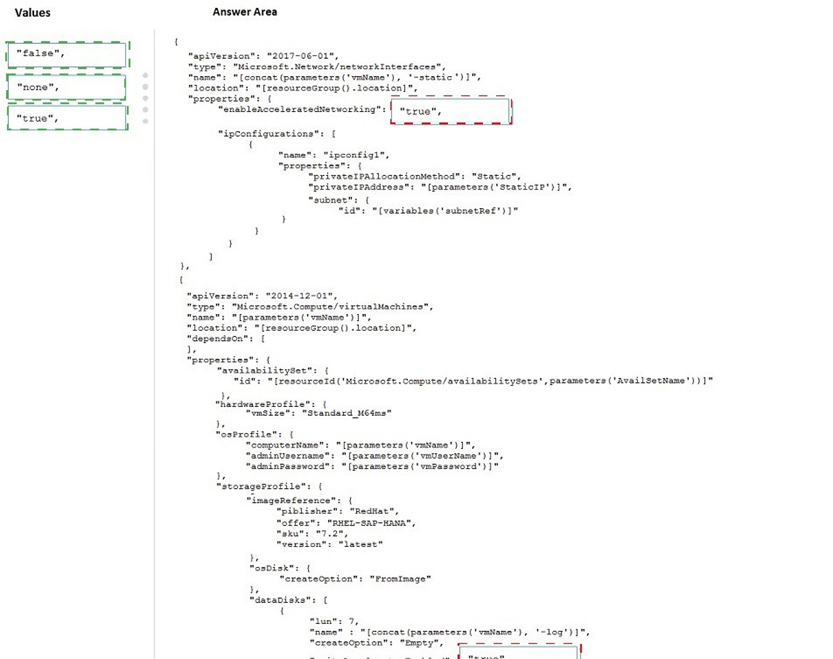
Explanation:
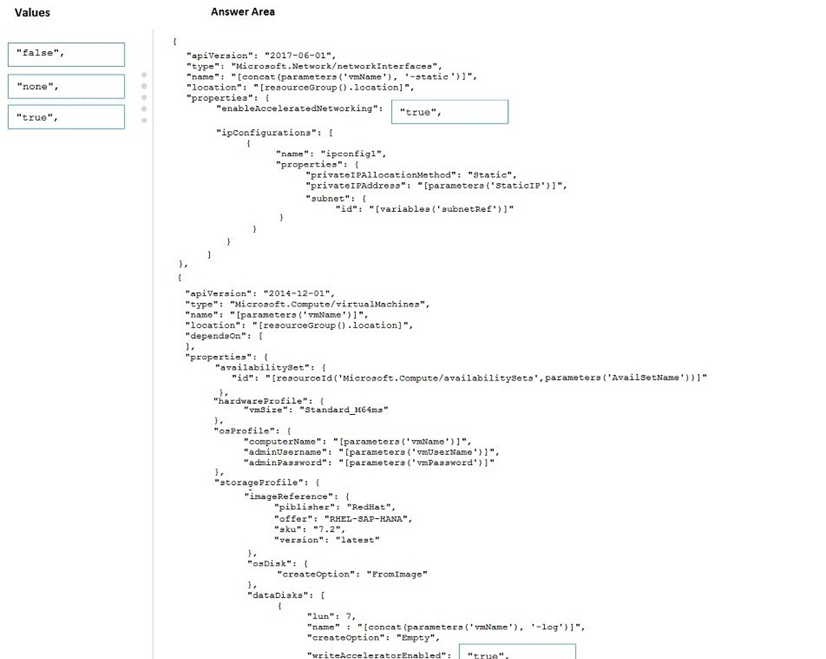
Box 1: true
enableAcceleratedNetworking: If the network interface is accelerated networking enabled. To further reduce network latency between Azure VMs, we [Micorosoft] recommend that you choose Azure Accelerated Networking. Use it when you deploy Azure VMs for an SAP workload, especially for the SAP application layer and the SAP DBMS layer.
Box 2: true
Write Accelerator should be used for the volumes that contain the transaction log or redo logs of a DBMS. It is not recommended to use Write Accelerator for the data volumes of a DBMS as the feature has been optimized to be used against log disks.
References:
https://docs.microsoft.com/en-us/azure/virtual-machines/workloads/sap/dbms_guide_general
| Page 8 out of 19 Pages |
| Previous |